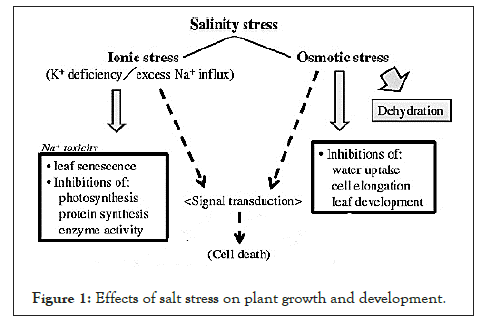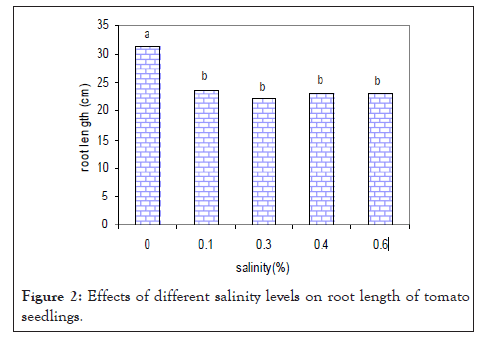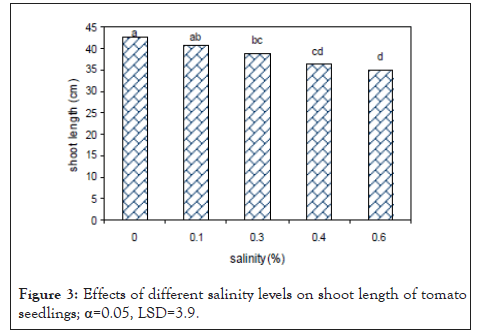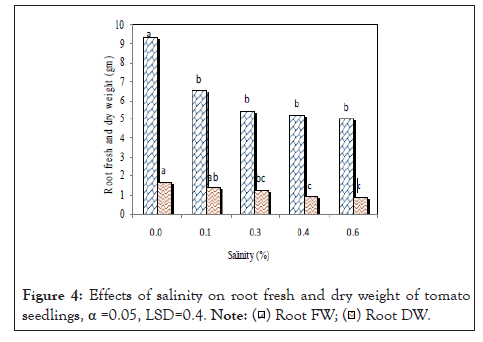Journal of Agricultural Science and Food Research
Open Access
ISSN: 2593-9173
ISSN: 2593-9173
Review Article - (2022)Volume 13, Issue 3
Tomato (Solanum esculentum L.) and Hot pepper (Capsicum annum L.) are vegetables categorized under the solanaceae family grown best around the warmer climate area of the world. However, their production and productivities have been challenged by biotic and abiotic factors like salinity stresses. The salinity stress is occurred mainly due to the presence of higher Na+ and Cl- ions concentrations in the soil which has been developed through frequent uses of poor-quality irrigation water and application of excessive mineral fertilizers for a longer period on the arable land. The salinity stress affected about 20% of the total cultivated land and 30% of irrigated agricultural land areas and it will be expected to rise to 50% in 2050 in the global. This stress degrades the fertile agricultural lands and causes direct and indirect impacts on the growth and development as well as productivities of the crops. Thus, it reduces the water potential and causes ion imbalance or disturbances in ion homeostasis that causes ionic toxicity by altering the water status leading to crops initial growth reduction. Crops differ in their ability to grow successfully under saline conditions and to accumulate high concentrations of salts in their tissues. However, tomato and hot pepper are moderately susceptible solanaceous crops to the salinity stresses. The stress mainly affects their leaf stomatal conductance by reducing the normal photosynthetic rate that directly affects the crop dry matter accumulation and reduces the yield. It further affects the speed and rate of seed germination, the crops growth and developments, root-to-shoot ratio, biomass weight, Na+/K+ ratio (increases) and the final yield qualities and quantities. However, the increment of salinity stress to these crops can enhance the fruit Total Soluble Solids (TSS). Thus, this pepper is aimed to review the current potential effects of salinity stress on selected solanaceous crops (tomato and hot pepper) production.
Developments; Growth; Ionic toxicity; Salt concentration; Yield
Vegetable crops production plays a key role in food security and it can provide the food and raw materials for industries, income from sales, and employment for small households in urban and peri-urban areas in most countries of the world [1]. The solanaceous crops (tomato and hot pepper) are the popular vegetable crops grown best around the world's warmer climatic conditions with rain-fed and irrigation water.
Tomato (Solanum esculentum L.) is globally the most important, widely grown, and consumed solanaceous vegetable next to potatoes [2]. It is mostly produced in warmer climatic conditions under rain feed and irrigation water. The crop requires an optimum temperature range between 11-35°C and well-drained loamy soil with pH ranges between 6 to 7 for successful growth, development, and quality yield production [2]. The trends of world tomato production are shown at an increasing rate from year to year due to its higher demands for healthy nutritional (vitamins, minerals, and antioxidant) values and economic benefits by the growers and traders in different levels of the value chain [1-3].
Hot pepper (Capsicum annuum L.) is also a vegetable best grow in warmer climate conditions at the temperature range of 18°C-30°C and well-drained sandy loam soil with a range of pH 5.5-6.8 [4,5]. The global hot pepper production status shows an increasing rate for its healthy nutritional (vitamins, minerals, and antioxidant) values and culinary (berbere, mitmita, and others) purposes, sources of raw material for industries (capsaicin and color oleoresins production), and economic benefits for the growers and trader in different levels of the value chain [3,6,7].
Despite their wider demands for healthy nutritional values and economic benefits, tomato and hot pepper productions have been greatly challenged by biotic or abiotic factors like soil salinity stresses. Salinity stress is one of the main environmental factors interfering with the growth, development, and biomass production of crops [8]. Thus, the salinity stresses can be developed due to the excessive accumulations of Na+ and Cl- ions concentrations in the soil through frequent uses of poor-quality of irrigation water and application of excess mineral fertilizers on the arable lands for longer periods [9]. Hence, after the salinity has been developed in the soil, it starts affecting almost every aspect of the physiology and biochemistry of plants and significantly reduces the yield quality and quantity of the crops [10].
The global soil salinity has been estimated to affect about 20% of the total cultivated and 30% of the irrigated agricultural lands [11]. The world salanized agricultural land has been increasing annually at the rate of 10% due to climate change, excessive use of groundwater (if near to sea), availability of low precipitation, presence of high surface evaporation, weathering process of native rocks in the soil, increasing uses of low-quality water in irrigation and massive introduction of irrigation associated with intensive farming and poor drainage which will be expected to rise to 50% at 2050 [12-14]. To date, about 1,125 million hectares of agricultural lands have already been seriously affected by salinity, thus, imposing a considerable serious threat to agricultural production [14].
The salinized agricultural land can reduce the productivity of many crops, including solanaceous vegetables (tomatoes and hot pepper). Hence, tomatoes and hot pepper are the most produced vegetables around the arid and semi-arid areas of the world even though they are moderately sensitive to soil salinity entire of their developmental stages [15]. But, the plant response to salinity differs at various stages of the growth cycle. This salinity stress could considerably affect the growth and development of both crops by influencing their physiological and biochemical processes. Thus, the stress can reduce the crops' growth, yields, and in severe cases, cause crop failure [16]. Due to these and other reasons, this paper is aimed to review the potential effects of soil salinity on solanaceous (Solanum esculentum L. and Capsicum annuum L.) crop production.
Salinity effects on growth and developments of crops
In the 21st century, one of the critical challenges of global crop production is the increment of soil salinity stress in agricultural land. It became the most devastating problem causing major losses in cultivated land, crop productivities, and crop qualities that will be the main constraint to feed the ever-rising of world populations [11]. This salinity stresses limits plant growth and development and even can put the whole plant parts to death which decreases crops production by causing billions of dollars in crop damages every year [17]. Thus, salinity occurs through natural or human-induced processes, and since it has been caused due to the presence of an excessive amount of Na+ and Cl- in the soil and water [18]. Hence, its presence can reduce the water potential and ion imbalances, or disturbances ion homeostasis, and can create toxicity which alters the water status of the plants leading to a reduction in initial plant growth and limits the crop production and productivities [17].
The soil salinity can be defined as one in which the Electrical Conductivity (EC) of the saturation extract (ECE) in the root zone exceeds 4 dSm-1 (approximately 40 mM NaCl) at 25°C and has exchangeable sodium of 15%. Most of the crop yield is reduced at this ECE, even though many crops exhibit yield reduction at lower ECEs due to the salinity mainly cause ion toxicity, osmotic stress, or nutritional imbalance (N, Ca2+, K+, P, Fe, Zn) and oxidative stresses to the growing plants [12,19]. Thus, the effects of excessive accumulation of sodium ions in cell walls can rapidly lead to osmotic stress and cell death of the plants as shown in Figure 1 [20]. Also, the presence of a higher amount of Na+ in the plant tissue has a strong inhibitory effect on potassium uptake by the plant root. On the other hand, the potassium ions deficiency inhibits the plant growth processes because potassium, as the most abundant cellular cation, plays a critical role in maintaining cell turgor, membrane potential, and enzyme activities in the plants [21]. In addition, the salinity stress greatly affects the plant photosynthetic activities mainly by reducing the plant leaf area, chlorophyll content, and stomatal conductance, and to a lesser extent decreases the efficiency of photosystem-II. In addition, it can affect the reproductive development of plants that inhibits the microsporogenesis, stamen, and filament elongation, enhancing programmed cell death in some tissue types, ovule abortion, and senescence of fertilized embryos [11]. Further, the presence of high salinity in the root zone severely impedes the normal growths and developments by creating the physiological drought and disturbing the metabolic activities that finally brings the plants to have smaller leaves, shorter stature, and sometimes fewer leaves leading to yield and economic loss [20] (Figure 1).

Figure 1: Effects of salt stress on plant growth and development.
Effects of salinity on solanaceous vegetable production
The global solanaceous vegetable (tomato and hot pepper) crops production has been threatened by increasing soil salinity, particularly in irrigated arable land areas of the arid and semi-arid areas [22]. These crops (both) are moderately sensitive to the salinity effect and can be affected adversely by increasing the amount in the soil up to the plant's death throughout its ontogeny. In a dry and hot environment, the amount of soil salinity is increasing due to higher evapotranspiration is leaving a large amount in the soil. However, the presence of salinity in the soil fluctuates with the season, being generally high in the dry season and low during the rainy season when fresh water flushing is prevalent [22]. Thus, the effects of salinity on both solanaceous vegetables will be discussed below in detail.
Effect of salinity on tomato (Solanum esculentum L.) production: Tomato (Solanum esculentum L.) is one of the most important vegetables that is adversely affected crop by salinity stresses starting early from the germination time until the final harvesting period. Hence, the production and productivity of the crop in arid and semi-arid areas are decreasing due to the adverse impacts of salinity on the physiological and biochemical processes of the crop. Thus, different findings were reported as the growth, development, and yields of tomatoes are significantly affected by the presence of salinity at all its developmental stages [23]. However, the response of tomatoes to salinity stress at different developmental stages varies with different genotypes [15].
The salinity stress greatly affects the seed germination, speed of germination, crop biomass, leaf numbers, root and shoot lengths, and the yield quality and quantity of tomato [24,25]. The report obtained from different research studies are supports this statement. According to the study of [26] reported, the seed germination of tomato varieties was highly affected by applications of higher salt concentration than the lower concentrations. This might be due to the higher salt concentration could affect the germination process by limiting the water absorption of the seed, excessive use of the nutrient pool, and creation of disorders in protein synthesis [25]. The salinity stress can also highly affect the emergence and development of tomato seedlings. In line with this, [27] were studied the effects of salinity stress on the seedling growth and developments of tomato varieties. They reported that the seedlings treated with the higher NaCl salt concentration were reduced the root and shoot lengths as shown in Figures 2 and 3, root fresh and dry weight as shown in Figure 4, and the leaf numbers than the seedlings treated with lower salt concentrations. Similarly, the study of [15] was reported the reduction in overall growth performances at all the developmental stages, fruit qualities, tissue constituents by a slight reduction of water contents and increments of inorganic ion concentrations [28,29]. Also, were studied the effects of salinity stress on tomatoes in a tissue culture laboratory. They reported that the culture media treated with the higher salt concentration were reduced the survival rate and callus growth of the culture even in salt-tolerant tomato genotypes. These effects of salinity stresses on the overall performances of tomatoes could be due to the higher salt concentration caused a low water potential zone in the soil making it increasingly difficult for the plant to acquire both waters and nutrients resulting in forming the physiological drought [30]. On the other hand, the crop has physiological limits to salt concentration which the above a certain threshold will reduce crop yields or cause the death of the plant [31].

Figure 2: Effects of different salinity levels on root length of tomato seedlings.

Figure 3: Effects of different salinity levels on shoot length of tomato seedlings; α=0.05, LSD=3.9.

Figure 4: Effects of salinity on root fresh and dry weight of tomato
seedlings, α =0.05, LSD=0.4. .
.
The salinity also induces some tomato diseases [32]. For instance, the incidence of blossom end rot in tomatoes can be increased in saline soils than in normal conditions. Thus, the salinity stress changes the morphological, physiological, and biochemical processes of tomatoes which in turn causes a problem to the water and ion uptake and reduces the crop growth and developments and causes the final yield loss. However, the tomato fruit's Total Soluble Solids (TSS) were found to increase for the plants grown in saline soil [33].
However, the efforts to breed tomato cultivars and graft tomato seedlings on rootstock for salinity-resistant shows promising results for future tomato production in arid and semi-arid areas (Figures 2-4) [34,35].
Effects of salinity on hot pepper (Capsicum annum L.) production: The salinity stress is becoming the most limiting factor to the global hot pepper production [36]. The crop is classified as moderately sensitive to salt stress among solanaceous crops [37,38]. Several studies were reported the effects of salinity stresses on hot pepper production. The effects were considerably observed as the stress affecting the field and greenhouse-grown pepper production [39]. Hence, the studies were reported that the effects of salinity on Capsicum annum L. observed on seed germination, seedling emergence, growth and developmental stages to the harvesting periods. The presence of higher salt concentration in the soil delays the seed germination rates and reduces the germination percentage of hot pepper [40]. The study of [41] reported the effects of salinity on the seedling developments of four commercial peppers cultivars (NuMex Joe E. Parker, NuMex Nematador, NuMex Primavera, and Jupiter) in a greenhouse. They found that the treatments irrigated with 3.0 or 6.0 dSm-1 NaCl solutions were not showed the seedling emergence at all than the pepper cultivars treated with lower salt concentrations. Similarly, study of [42] reported the effect of salt stress (NaCl) on the germination and early seedling parameters of three pepper cultivars (Capsicum annuum L.). They observed as the recorded traits were affected by the applied salt concentrations. Further, the study indicated as the concentrations of NaCl increased, the length of pepper cultivars plumule and radicle were significantly reduced. Additionally, [43] were studied the effects of NaCl on the germination and seedling emergence of chilli pepper. They reported the stress of NaCl significantly decreased the shoot and root length, seedling height, seedling fresh and dry weight of chilli genotypes. In line with this finding, [44] were reported the reduction of the root and shoot length, dry matter contents of roots, stems, and leaves, relative growth rate, leaf area, specific leaf area, and leaf area ratio of hot pepper by higher levels of salt concentration (6 and 8 dSm-1) than the lower levels. However, the chlorophyll and carotenoid contents of the capsicum showed higher results at 6 dSm-1 than the control. Further, [45] were reported the decrement in the relative growth rate of hot pepper and reduction in leaf number and leaf area, shoot and root length, fresh and dry weight of root, shoot and the whole plant, and the K+/Na+ ratio in seedlings treated with higher salt concentration. Hence, the salinity stresses to the hot pepper production starts when the Electrical Conductivity (EC) of saturated soil extraction is greater than 1.5 dSm-1 [41].
The salinity stresses can also greatly affect the yield and qualities of hot pepper productions. According to different studies reported that supplying irrigation water with higher levels of salt concentration, greatly affected the plant growth, photosynthetic pigments production and total phenols contents of Capsicum annum L. The study of [46] was similarly reported the reduction in fruit weight of hot pepper irrigated with the water contain higher level of salt concentration than the tap water. Similarly, [47] were studied the effects of salinity on the hydroponically grown pepper in the greenhouse. They observed the reduction in fruit size, marketable yield, total soluble solids, and fruit firmness at the green, turning, and red maturity levels of hot peppers. Further, the studies of [48] were reported the reduction of yield and biomass of pepper grown at soilless closed system. These adverse effects of salt stress might be caused due to the salt concentration strict availability and uptake of water leading to the decrement of water content in the plant tissues that alters the metabolic processes inside the cells. Hence, the presence of high salt concentration in the irrigation water can cause direct and indirect effects on leaf water relations and stomatal closure which reduces the CO2 exchange and photosynthetic rate of the crop. Furthermore, the negative effects of salinity have been attributed to the disturbance in either protein assimilation [49,50], mineral uptake and distribution, growth hormones activities enzymes activities and oxidative defense of the plants which finally resulted in the reduction of yield and quality of the crop [51-57].
Demographic characteristics
Salinity stress is becoming a huge problem for agricultural sector. Currently, global soil salinization is increasing at an alarming rate and is predicted to rise by 50% in 5050 from what is now affecting the agricultural land. The soil salinity can be caused by climate change, excessive use of ground water, increasing uses of low-quality water in irrigation, and massive introduction of irrigation associated with intensive farming and poor drainage of water from the agricultural land. The stress causes ion toxicity, osmotic stress, nutritional imbalance, and oxidative stresses to plants by imposing negative impacts on the physiological and biochemical processes of the solanaceous crops (tomato and hot pepper). The growth and development of tomato and hot pepper are highly affected by soil salinity throughout the ontogeny of the plants. Hence, the salinity stress can affect the seed germination and seedling emergence, relative growth rate, leaf area, number of leaves, root and shoot length, shoot to root ratio, dry matter contents of roots and shoot, biomass contents of both crops. Salinity stress also enhances the incidence of blossom end rot disease of tomatoes. However, the fruit quality of both crops is enhanced by the availability of moderate salinity in the soil. Generally, due to its deleterious effects, the global soil salinization problem needs urgent attention to mitigate its consequences by managing the global climate change, by properly utilizing mineral fertilization, by using quality irrigation water for crops production around the arid and semi-arid areas of the world.
[Crossref] [Google Scholar] [Pubmed]
[Crossref] [Google Scholar] [Pubmed]
[Crossref] [Google Scholar] [Pubmed]
[Crossref] [Google Scholar] [Pubmed]
[Crossref] [Google Scholar] [Pubmed]
[Google Scholar] [Pubmed]
[Crossref] [Google Scholar] [Pubmed]
[Crossref] [Google Scholar] [Pubmed]
[Crossref] [Google Scholar] [Pubmed]
[Crossref] [Google Scholar] [Pubmed]
[Crossref] [Google Scholar] [Pubmed]
Citation: Megersa HG (2022) Potential Effects of Salt Stress on Selected Solanaceous Crops (Tomato (Solanum esculentum L.) and Hot Pepper (Capsicum annuum L.)) Production. J Agri Sci Food Res. 13:494.
Received: 02-May-2022, Manuscript No. JBFBP-22-16127; Editor assigned: 04-May-2022, Pre QC No. JBFBP-22-16127 (PQ); Reviewed: 18-May-2022, QC No. JBFBP-22-16127; Revised: 25-May-2022, Manuscript No. JBFBP-22-16127 (R); Published: 06-Jun-2022 , DOI: 10.3389/2167-1044.22.13.494
Copyright: © 2022 Megersa HG. This is an open-access article distributed under the terms of the Creative Commons Attribution License, which permits unrestricted use, distribution, and reproduction in any medium, provided the original author and source are credited.